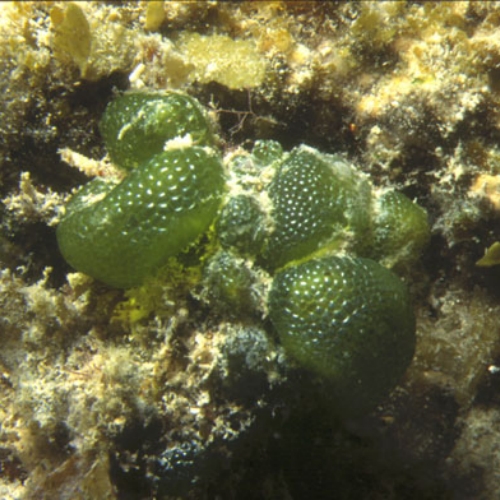
Main Page | References
Dictyosphaeria cavernosa (Forssk.) Børgesen

Dictyosphaeria cavernosa (Forssk.) Børgesen
Description: Plants forming hollow cushions or mats, to 12 cm in diameter. Younger plants spherical. Mature plants convoluted, frequently ruptured, and irregulary lobed. Attached to substrate by rhizoids extending from basal segments. Thallus pseudoparenchymatous, initially composed of a single layer of polygonal cells to 5mm in diameter. New cells develop inside parental cells, by segregative cell division. Isodiametric hapteroid cells that attach segments to one another 35-45 mm diam.Introduction and Origin: Native to Hawaii (Abbott, Smith) Both species of Dictyosphaeria are native to Hawaii. Invasiveness is attributed to a rise in nutrient contents in the water column.
Hawaiian Distribution: Northwest Hawaiian Islands, Oahu, Maui, Kauai, Lanai, Molokai, and Hawaii Island. Mainly only invasive with in Kane`ohe bay.
Habitat: Subtidal to 59 m deep. Attached to rock and rubble, or cement walls, in calm reef flats and tidepools.
Environmental Effects: D cavernosa smothers coral heads, and decreases the rugosity of the reef by filling in holes and crevices, which are no longer available for small fish to dwell in and hide from predators.
World Distribution: Type locality: Red Sea. Pacific and Indian Oceans, Arabian Sea, Eastern Atlantic and the Caribbean. Indigenous to the Hawaiian Islands.
Commercial Interests: None.
Rate of Spread / Method: Growth rates are highest in Fall and lowest in Spring, probably due to increased herbivory pressure during Summer and Fall.
Factors likely to influence Spread and Distribution: A reduction in herbivory pressure can be a major reason for an increase in abundance of D. cavernosa. As fishing activities increase, fish populations decline. The increase in the number of invertebrates that live within the hollow thalli of D. cavernosa, their excretions being an additional source of nutrients for the algae, may also be a reason for its success. In places of high water motion, such as the outer reef, D. cavernosa utilizes the flow of nutrients to sustain growth. During periods of slow water motion D. cavernosa cannot sustain its growth rate and its abundance decreases. In places of low water motion, the plant may obtain nutrients from the sediment (Larned, 1997).The best solution to control D. cavernosa is to inhibit its growth during the spring and winter months when the growth of D. cavernosa is at a minimum.
Reasons for Success: Both species of Dictyosphaeria are able to utilize the nutrient contents in the water and within the sediment. By providing habitat for invertebrates to live, more nutrients are added internally. Nutrient levels are significantly higher in stored, enclosed spaces of the thallus (Stimson 1995), sometimes doubling the concentrations in the water column (Larned,1996). The process of growth in Dictyosphaeria cavernosa is described best by J.Stimson et al (1996) J. Exp. Mar. Biol. Ecol. 196 53-77. "Thali develop from segregative cell divisions within the large multinucleate cells, followed by expansion of the daughter cells and attachment between cells via minute haptera(Egerod, 1952). Hollow 1-10 cm diameter spheres form after repeated cell divisions, and these may rupture as the spheres expand. As adjacent spheres coalesce, a 2-10 cm thick thallus develops. Thalli growing on branches of coral colonies." As D. cavernosa expands around the coral heads the spheres begin to be inhabited by smaller invertebrates, thus increasing the nutrient load within each sphere. Another attributed factor is that the growth rate for the thallus is greatest at 20% of full sunlight (Stimson, 1996).
Control Methods: None used. Reduction of eutrophic conditions (high nutrient levels) both in sediments and water column. Protection of the habitat of herbivorous fishes. Erradication should be implemented during winter and spring, when the growth rate of Dictyosphaeria sp. is at a minimum. Other control methods are the cleaning of the marine sediments in Kane'ohe bay by releasing the nutrients stored within them. Initial pulses of nutrients into the water column will cause quick blooms. However, it is the constant, slow release of nutrients stored within the sediments that provide for the high growth rate of this algae.
References: Stimson, J. and S. Larned. and K. McDermid, 1996. Seasonal growth of the coral reef macroalgae Dictyosphaeria cavernosa(Forskal) Borgesen and effects of nutrient availability, temperature and herbivory on growth rate. J.Exp.Mar.Biol.Ecol., Vol 196. Pp. 53-77 Larned, S.T. and Atkinson, M.J, 1997. Effects of water velocity on NH4 and PO4 uptake and nutrient limited growth in the macroalga Dictyosphaeria cavernosa. Mar. Ecol. Prog. Ser., Vol 157. Pp.295-302 Larned, S. Stimson, J. 1996. Nitrogen-limited growth in the coral reef cholorphyte Dictyosphaeria cavernosa, and the effect of exposure to sediment-derived nitrogen on growth. Marine Ecology Progress Series. 145:95-108. Smith, C, Bot 351.University of Hawaii, Manoa campus.2000.